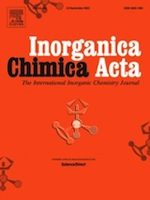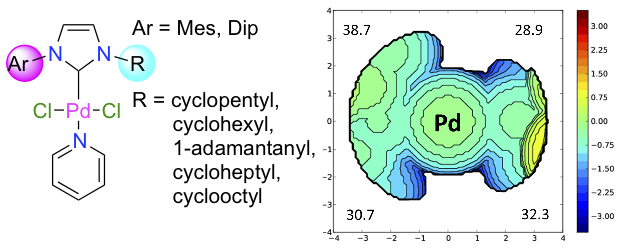"Synthesis, Characterization, and Catalytic Evaluation of Palladium PEPPSI Complexes Bearing Unsymmetrical NHC Ligands in Suzuki-Miyaura Reactions"
François Mazars, Guillermo Zaragoza, and Lionel Delaude
 |
source: Inorganica Chimica Acta
year: 2023
volume: 556
article: 121676
pages: 9
doi: 10.1016/j.ica.2023.121676
|

Abstract: Seven unsymmetrical imidazolium chlorides featuring a mesityl or 2,6-diisopropylphenyl substituent on one of their nitrogen atoms and a cycloalkyl group of variable size (cyclopentyl, cyclohexyl, 1-adamantanyl, cycloheptyl, cyclooctyl, or cyclododecyl) on the other one served to prepare a small library of novel palladium PEPPSI complexes with the generic formula [PdCl2(NHC)(Py)]. Three symmetrical compounds featuring the bulky yet flexible 1,3-dicyclododecylimidazol-2-ylidene and the archetypical IMes and IDip ligands were also synthesized. All the products were isolated in modest to satisfactory yields (15-85%) and fully characterized using 1H and 13C NMR spectroscopies. The molecular structures of five of them were determined using single crystal X-ray diffraction analysis, which revealed that, in most cases, the conformational freedom of the N-cycloalkyl moieties subsisted in the crystal phase. Topographic maps and %VBur parameters were computed to quantify the steric requirements of the uNHC ligands. The catalytic activity of the ten complexes was assessed in the Suzuki-Miyaura cross-coupling of phenylboronic acid and aryl halides. The reactions required only a low catalyst loading (0.05-0.25 mol%) and were carried out under mild aerobic conditions in a green, water-based solvent mixture. High yields of biphenyl derivatives were achieved with all the aryl bromides tested, irrespective of the presence of electron-donating or withdrawing substituents on their aromatic ring. When 4-chloroacetophenone, a representative electron-poor aryl chloride served as substrate, all the complexes featuring cycloalkyl substituents on their NHC ligand became mostly inactive, whereas the IMes and IDip-based catalyst precursors maintained a high activity
Keywords: Biaryls, Carbene Ligands, Cross-Coupling Reaction, Steric Map, Structural Analysis
[Full Text] [<< Previous Article] [Back to the List of Publications] [Next Article >>] l.delaude@ulg.ac.be